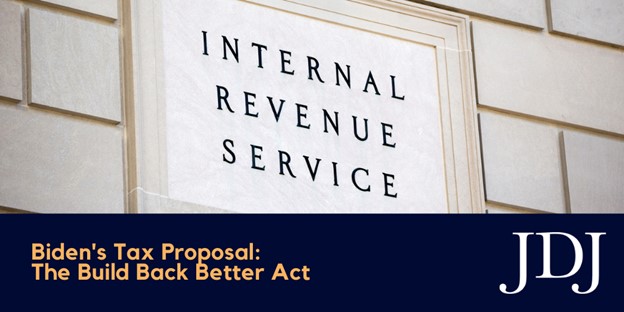Build Back Better Act: Updated Biden Tax Proposal

On November 3, the House Rules Committee issued an updated version of its new tax proposal known as the Build Back Better Act. The Act represents a drastic simplification of the original proposal released by the House Ways and Means Committee on September 13. The changes are in conjunction with President Biden’s infrastructure package being reduced from $3.5 trillion to $1.75 trillion.
Notably, the Build Back Better Act eliminates many of the proposed changes in the original legislation. The plan no longer includes any of the following:
- Increases in the top individual tax rates for ordinary income and capital gains
- Changes to the holding period for carried interests to qualify for long-term capital gains treatment
- Rollback of the gift/estate and GST lifetime exemptions
- Changes to grantor trust rules
- Modifications to estate tax valuation rules
As a follow-up to our previous series outlining the September 13 proposal, this article focuses on a number of the amended provisions contained in the Build Back Better Act that could affect high-net-worth (HNW) individuals. The pared-down version has the potential to reduce year-end planning implications significantly; however, this remains a very fluid situation, and the final regulations could still differ from this latest proposal.
Millionaire Surtax
- In lieu of the rate increases in ordinary income and capital gains taxes, the Build Back Better Act instead proposes a “millionaire surtax.” This is in addition to existing ordinary income and capital gains taxes, and would apply to taxpayers at the following income levels:
- 5% surtax on modified adjusted gross income (MAGI) in excess of:
- $10M for single filers
- $20M if married filing jointly
- $200,000 for estates and trusts
- Additional 3% surtax on MAGI in excess of:
- $25M for single filers
- $50M if married filing jointly
- $500,000 for estates and trusts
- This is in addition to the initial 5% surtax already applied to income in excess of the thresholds noted above.
- In effect, this results in a maximum marginal tax rate of 45.0% (top marginal ordinary rate of 37% + 5% surtax + 3% additional surtax), or 48.8% in cases where the 3.8% Net Investment Income Tax (NIIT) applies.
- 5% surtax on modified adjusted gross income (MAGI) in excess of:
- Planning Considerations:
- Because the income thresholds are at the modified adjusted gross income level, “below-the-line” deductible expenses such as charitable contributions would not reduce the surtax liability.
- Installment sales for one-time transactions might be advisable in order to spread out income over multiple years and minimize the impact of the surtax.
3.8% Net Investment Income Tax (NIIT)
- In addition to investment earnings and passive income (under the current law), the net investment income tax would also apply to net business income for taxpayers with taxable income greater than $400,000 (for single filers) or $500,000 (if married filing jointly).
- This provision is similar to what was in the original proposal released on September 13th.
State and Local Income Tax (SALT) Deduction
- The new proposal allows single and married filing joint taxpayers to deduct up to $72,500 per year in state and local income and real estate taxes. This would be in effect for tax years 2021 through 2031, after which the cap would be reduced to the current level of $10,000.
Qualified Small Business Stock (QSBS)
- The 75% and 100% gain exclusions for QSBS would be eliminated for the following (i.e., these taxpayers would only be able to exclude a maximum of 50% of capital gains from QSBS):
- Individual owners of QSBS with adjusted gross income over $400,000
- Trusts or estates that own QSBS
- This treatment would apply to sales on or after September 13, 2021.
- This provision is similar to what was in the original proposal released on September 13th.
- See our previous blog post for further explanation of the QSBS rules.
Retirement Accounts
The Build Back Better Act maintains many of the new regulations for contributions and distributions regarding “Mega IRAs” (i.e., retirement accounts with a value of $10 million or greater) that were included in the September 13 proposal. Many of these rules do not take effect until 2029 or later, however, as opposed to the 2022 effective dates in the original proposal. These provisions are explained in further detail below.
- Contributions
- Beginning on January 1, 2029, further contributions to a Roth or traditional IRA are disallowed if (1) the total value of the taxpayer’s IRAs exceeds $10 million as of the end of the prior tax year, and (2) the taxpayer’s income is greater than:
- $450,000, if married filing jointly
- $400,000, if single or married filing separately
- $425,000, if filing as head of household
- Beginning on January 1, 2029, further contributions to a Roth or traditional IRA are disallowed if (1) the total value of the taxpayer’s IRAs exceeds $10 million as of the end of the prior tax year, and (2) the taxpayer’s income is greater than:
- Required minimum distributions (RMDs)
- Beginning on January 1, 2029, there are new RMD rules for taxpayers (1) with total retirement account values greater than $10M as of the end of the prior tax year and (2) who have annual income greater than the limits above. Please note that the $10M and $20M thresholds below apply to the combination of all of the taxpayer’s traditional IRA, Roth IRA and defined contribution (e.g., 401k) retirement accounts. These RMDs are applicable regardless of the taxpayer’s age and are not eligible to be rolled over to another retirement account.
- RMD for retirement account values between $10M-$20M:
- RMD = 50% of the excess total account value over $10 million
- Example: if total retirement accounts are valued at $14M as of 12/31/2021, then 2022 RMD = $2M
- For retirement account values greater than $20M, the RMD is the combination of:
- The lesser of:
- Excess amount over $20M (when totaling all retirement account values, as outlined above), or:
- The entire balance in the account
- Plus:
- 50% of the amount between $10M-$20M, as described above
- One caveat to this rule is that those with account totals exceeding $20 million must pull from Roth IRAs and 401ks first.
- Example: As of 12/31/2021, taxpayer has a Roth IRA valued at $3M and total retirement accounts valued at $24M. The entire $3M IRA would need to be withdrawn in 2022, since the value is less than the $4M total excess over $20M. In addition, the taxpayer would need to withdraw $5M (50% of the value between $10M-$20M), resulting in a total RMD of $8M.
- The lesser of:
- RMD for retirement account values between $10M-$20M:
- Beginning on January 1, 2029, there are new RMD rules for taxpayers (1) with total retirement account values greater than $10M as of the end of the prior tax year and (2) who have annual income greater than the limits above. Please note that the $10M and $20M thresholds below apply to the combination of all of the taxpayer’s traditional IRA, Roth IRA and defined contribution (e.g., 401k) retirement accounts. These RMDs are applicable regardless of the taxpayer’s age and are not eligible to be rolled over to another retirement account.
- Roth IRA Conversions
- Beginning on January 1, 2032, Roth IRA conversions are disallowed for taxpayers with income greater than $400,000 (single), $450,000 (joint) or $425,000 (head of household).
- “Back-door” Roth IRA conversions (i.e., making non-deductible contributions to a traditional IRA and then immediately converting to a Roth IRA) are also disallowed beginning on January 1, 2032.
Because individual situations vary in terms of structure and complexity when it comes to tax planning, we recommend that you work with qualified advisors and tax professionals to evaluate and develop an appropriate strategy that fits your needs. Please contact me or a member of your JDJ team for assistance.



















